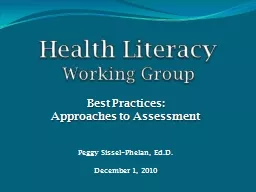

Literacy Working Group Best Practices Approaches to Assessment Peggy SisselPhelan EdD December 1 2010 Health literacy allows the public and personnel working in all healthrelated contexts to find understand evaluate communicate and use information Health lite ID: 369256
Download Presentation The PPT/PDF document "Health" is the property of its rightful owner. Permission is granted to download and print the materials on this web site for personal, non-commercial use only, and to display it on your personal computer provided you do not modify the materials and that you retain all copyright notices contained in the materials. By downloading content from our website, you accept the terms of this agreement.
Slide1
Health LiteracyWorking Group
Best Practices:
Approaches to Assessment
Peggy Sissel-Phelan,
Ed.D
.
December 1, 2010Slide2
Health literacy allows the public and personnel working in all health-related contexts to find, understand, evaluate, communicate, and use information. Health literacy is the use of a wide range of skills that improve the ability of people to act on information in order to live healthier lives. These skills include reading, writing, listening, speaking, numeracy, and critical analysis, as well as communication and interaction skills. (Calgary Charter on Health Literacy, 2008)Health Literacy DefinedSlide3
Health literacy allows the public and personnel working in all health-related contexts to find, understand, evaluate, communicate, and use information. Health literacy is the use of a wide range of skills that improve the ability of people to act on information in order to live healthier lives. These skills include reading, writing, listening, speaking, numeracy, and critical analysis, as well as communication and interaction skills. (Calgary Charter on Health Literacy, 2008)Health Literacy
Operationalized
ROLES
Health literacy allows
the public and personnel working in all health-related contexts
to find, understand, evaluate, communicate, and use information. Health literacy is the use of a wide range of skills that improve the ability of people to act on information in order to live healthier lives. These skills include reading, writing, listening, speaking, numeracy, and critical analysis, as well as communication and interaction skills. (Calgary Charter on Health Literacy, 2008)
Health literacy allows
the public
and
personnel working in all health-related contexts
to find, understand, evaluate, communicate, and use information. Health literacy is the use of a wide range of skills that improve the ability of people to act on information in order to live healthier lives. These skills include reading, writing, listening, speaking, numeracy, and critical analysis, as well as communication and interaction skills.
(Calgary Charter on Health Literacy, 2008)Slide4
Health Literacy Operationalized
Health literacy allows
the public
and
personnel working in all health-related contexts
to find, understand, evaluate, communicate, and use information. Health literacy is the use of a wide range of skills that improve the ability of people to act on information in order to live healthier lives. These skills include
reading, writing, listening, speaking, numeracy, and critical analysis, as well as communication and interaction skills. (Calgary Charter on Health Literacy, 2008)
Health literacy allows
the public
and personnel working in all health-related contexts to find, understand, evaluate, communicate, and use information. Health literacy is the use of a wide range of skills that improve the ability of people to act on information in order to live healthier lives. These skills include reading, writing, listening, speaking, numeracy, and critical analysis, as well as communication and interaction skills. (Calgary Charter on Health Literacy, 2008)
ROLES
METHODSSlide5
Health literacy allows the public and personnel working in all health-related contexts to find, understand, evaluate, communicate, and use information. Health literacy is the use of a wide range of skills that improve the ability of people to act on information in order to live healthier lives. These skills include
reading, writing, listening, speaking, numeracy, and critical analysis, as well as communication and interaction skills.
(Calgary Charter on Health Literacy, 2008)
Health Literacy
Operationalized
ROLES
Health literacy allows the public
and
personnel working in all health-related contexts
to
find, understand, evaluate, communicate, and use information.
Health literacy is the use of a wide range of skills that improve the ability of people
to act on information in order to
live healthier lives.
These skills include
reading, writing, listening, speaking, numeracy, and critical analysis, as well as communication and interaction skills.
(Calgary Charter on Health Literacy, 2008)
OUTCOMES
METHODSSlide6
Level of understanding OF health contexts Clinical/Self help
Access/Navigation
Prevention/Treatment
Chronic/Acute
Emergency/Routine
Patients ~
Bring varied “ability to act on information to improve health” due to
Level of skills
IN
health contexts
Locating
Decoding
Inferring
Formulating
questions InterpretingSlide7
Varied understanding of their patients’ health contexts
Clinical/Self help
Access/Navigation
Prevention/Treatment
Chronic/Acute
Emergency/Routine
Providers ~Vary in “ability to help patients find, understand, evaluate, communicate, and use information” due to
Varied level of
skills
t
hat help enable their
patients in
Locating
Decoding
Inferring
Formulating
questions
InterpretingSlide8
Varied understanding of their patients’ health contexts
Clinical/Self help
Access/Navigation
Prevention/Treatment
Chronic/Acute
Emergency/Routine
Providers ~Vary in “ability to help patients find, understand, evaluate, communicate, and use information” due to
Varied level of
skills
t
hat help enable their
patients in
Locating
Decoding
Inferring
Formulating
questions
Interpreting
Slide9
The Core of Best Practice
Cultural
Competency
Slide10
MethodsCulturalCompetency
Roles
Outcomes
Components of Best PracticesSlide11
Components of Best PracticeMethodsCulturalCompetency
Roles
Outcomes
Tools
Training
SystemsSlide12
Components of Best PracticeToolsCulturalCompetency
Training
Systems
Materials
Means
Supports &
Services
Clinical InteractionPolicies
ProcessesSlide13
ToolsPlain Language
Components of Best PracticeSlide14
Addresses varied health contexts Plain Language
i
n
accessible ways
Locate Decode Question Understand
Health Information
and Health
s
o patients are better able to
Slide15
Passive sentences Long paragraphs
Poly-syllable words
Clinical language
Past/mixed tense
3
rd
person
(they, s/he) Active sentencesShort paragraphsMono or bi-syllableColloquial languagePresent tense2nd
or 1
st
person
(you, I
)
Plain Language
and HealthSlide16
Plain Writing Act of 2010 (Public Law No: 111-274) Federal agencies must use “plain writing” All “covered documents” issued to public ~ Letters, publications, forms, notices, instructions ~ Anything relevant to federal benefits or requirements Signed Oct. 13, 2010; begins in 1 year
Plain Language:
It’s the LawSlide17
http://www. plainlanguage.govPlain LanguageSlide18
Plain Languagehttp://www.nih.gov/clearcommunication/plainlanguage.htm